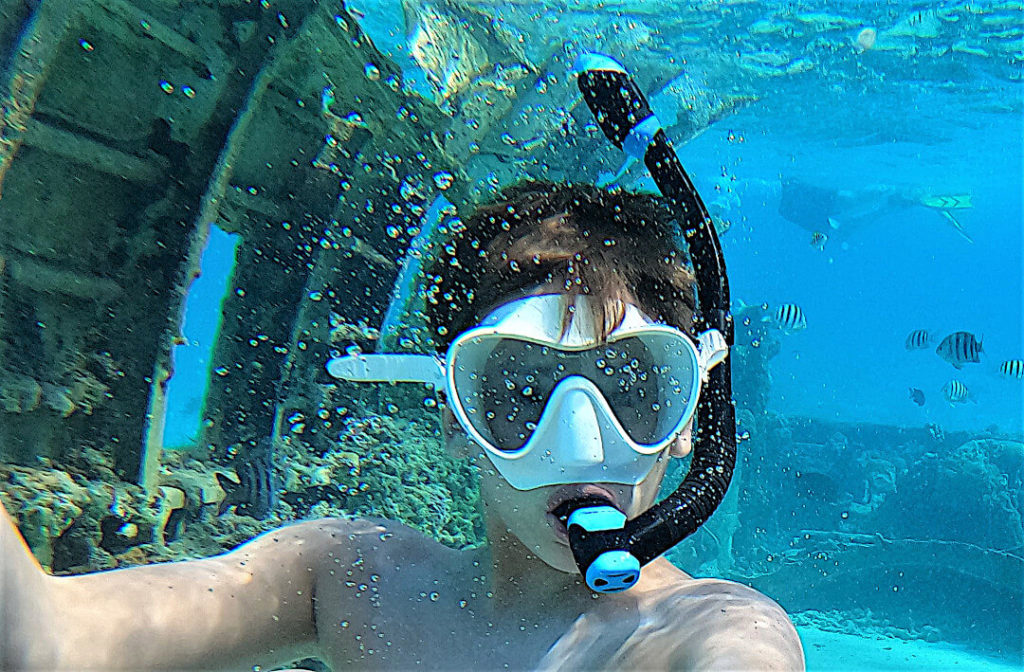
When it comes to gifts for birthdays or holidays, give your crewmates something they’ll need on the water. You and your friends have dropped some serious coin to book a bareboat charter. A boating gift will keep everyone excited about the upcoming trip and help stretch the crew’s dollars a bit further. Here are a few key items that the crew at Busy Boater really appreciated while cruising this year. I get commissions for purchases made through links in this post.
Digital Voltmeter/USB Adapter
If you ever rent older boats, you’ll often encounter two annoyances: 1) no USB plugs to charge all your crap and 2) hard to read analog voltmeters. After our il fated trip to Catalina Island, I picked up one of these and added it to my packing list. No more reading the meter from the wrong angle, estimating the distance between 12.0 and 12.5 volts, or hoping that it is properly calibrated. Now I bring this digital meter that I know is accurate all the time. It also does double duty as a USB charger with (XXX? fast charging).
Of course, this can be fallible if your 12-volt outlet is a long run from the batteries, which will cause a voltage drop. However, if you pick up a rental and find this condition, at least you have a chance to chase it down and make sure you’ve got a solid charging system before leaving the dock.
We have an old Jeep with a questionable battery, but this gadget has given me the confidence to keep it in service for a full year.
Best Non-Marking Flip-Flops for Boaters: Crocs
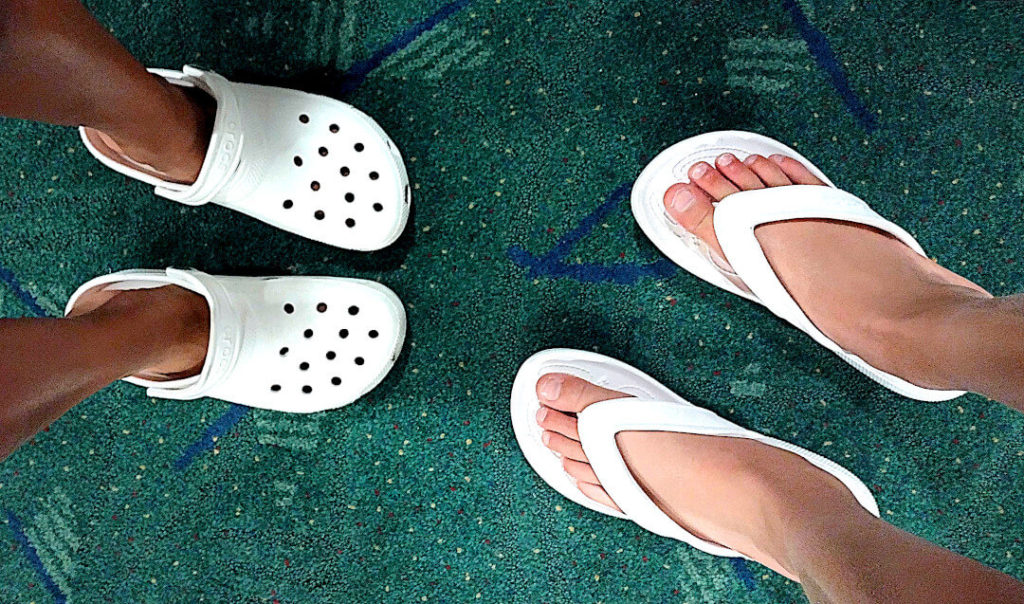
Okay, okay, you are hesitant on this one for a few reasons. Crocs? Really? And flip flops are not a sturdy choice for a deck shoe. While I’ve got some well-worn Locals that set me back about $2 and some nice leather OluKais at the other end of the spectrum, both have black, marking soles. I wanted a pair of cheap non-marking flip flops that I could wear ashore and not worry about marring the dinghy or the boat deck when back in the water. Mind you, they don’t see much use on the boat itself, as going barefoot really is the safest and most comfortable way to move about a wet, uneven boat deck.
Anyway, when I found Croc Flip Flops with non-marking soles at a great price in a variety of colors, I was hesitant. Personally, I’m not a fan of the original Crocs. However, we ordered pairs for myself, George, and Rachel. The Classic II Models we got have a sole identical to original Crocs, but replace the unconventional topsides with a flip-flop thong. Here’s why Crocs are the best flip-flops for boaters:
Are Crocs Flip-Flops Comfortable?
After wearing them for just a few hours, I came to appreciate why the original Crocs are so popular, The sole is damn comfortable. I had been having some foot pain for a few months that was probably cause by wearing archless shoes such as the aforementioned Locals as well as Topsiders daily. The strong arch support in these flip flops has fixed that problem. I wear them in the house now instated of going barefoot. I walk for miles in them every week and my feet are better for it. Rachel is equally enamored with hers, despite prior preference for much fancier footwear. My only complaint is that the sole doesn’t breath, so the bottoms of my feet sometimes get pretty sweaty.
Are Crocs Flip-Flops Durable?
Online reviews often complain about the durability of these flip-flops. Lots of people have complained about the thong separating from the sole in different places. While the thong is the weak point in the design, we’ve got six pairs making hundreds of miles without incident. These sandals are made from only two parts with the top of the thong being molded as one piece with the sole. The stem that goes through the toes is a separate piece that is attached under the thong.
I have a single pair that I’ve taken on every Busy Boater trip for the last 18 months. At home I put about 4 miles on them every week. The tread is wearing thin on one side of the heels. Other than that, they’re as good as the day I got them.
Which Crocs Flip-Flops Should You Buy?
There are also newer designs with sleeker looks, such as the Kadie and the Athens. However, the thick sole of the Classic models have the arch support and cushion while keeping your toes elevated above some of the brush when hiking on trails. Get the original Classic if you want holes in the thongs to attach Crocs charms, or the Classic II if you prefer to just do the bare minimum when it comes to flair. These can be the only shoes you pack for many trips, although I like to wear water shoes when snorkeling to keep my feet warm and not get cut if I bang on some coral or lava rock.
Best Rigging Knife for Sailors
There are three tiny things on sailboats that are annoying without tools: Untying tight knots, twisting shackles, and opening split rings. All three can be made far easier with the right rigging knife.
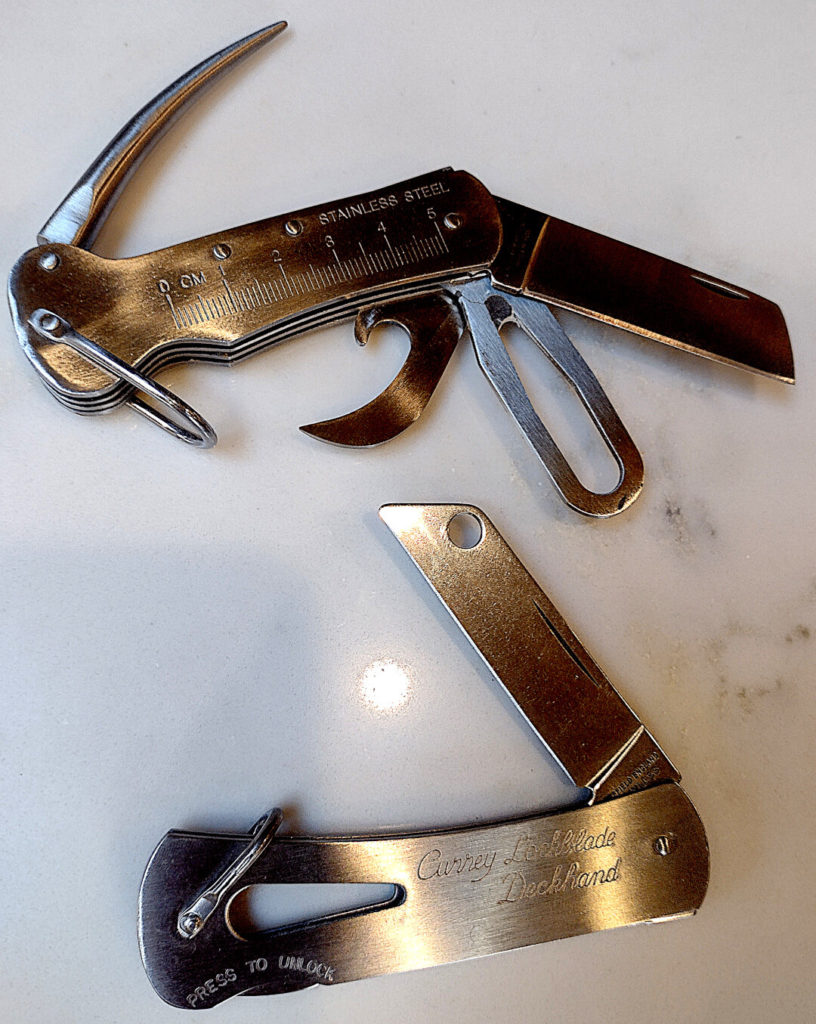
Budget Option: Meyerco Rigging Knife. I bought Meyerco rigging knife because it was cheap. Since the knife blade isn’t that important in this tool, we just wanted the cheapest stainless folder with a marlinspike and a shackle key. The shackle key is pretty big, so might not work on very small boats. It’s also not very sturdy: the first time I used it, I broke it. However, I must disclose that I wasn’t using it on shackles. I was tightening a bolt on an outboard motor mount that had lost its handle. So I was really muscling on it when it broke. We’ve since fixed it with a bit of J.B. Weld and its good for light shackle work again, only with a bit more character.
If only the best will do, the Captain Currey Bosuns Mate is the way to go. Unlike the Meyerco version, Captain Currey knives have the shackle key cut into the handle, making them much sturdier. US distributors have been sold out for months, but thanks to parliament, conversion rates to the British Pound are pretty favorable these days. So you might even save a few quid buying it direct from the UK like I did. Just don’t cheap out on the Deckhand model only to discover later that it doesn’t include a lockspike…like I did.
Best Carry-On Duffle Bag for Boaters
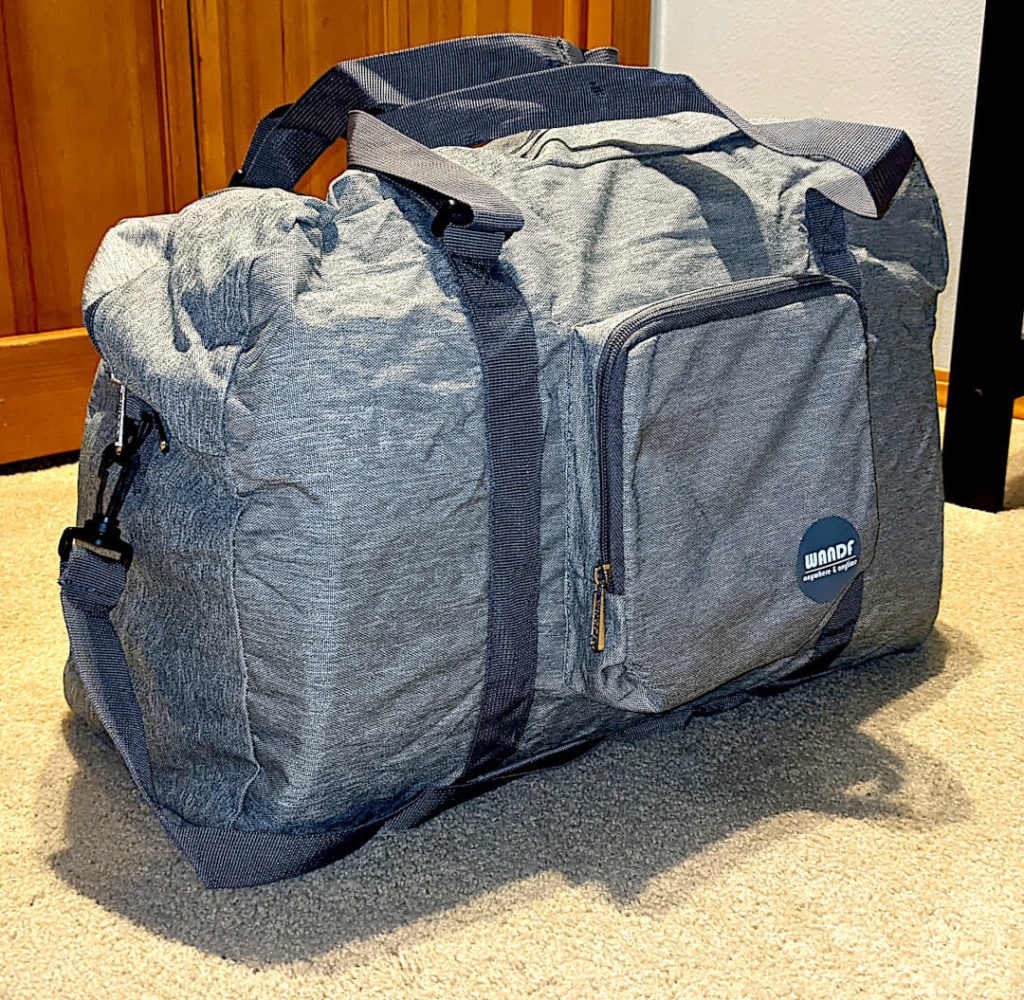
Traditional rollaboard suitcases don’t work well on boats because there’s not usually a good place to store all that bulk. Features to look for in luggage for bareboat chartering:
- Collapsible: this is the most important feature because you usually need to unpack your luggage and stow your bags on the boat (as opposed to having a place to leave them ashore)
- Sized for Carry-On: If you can carry on all of your luggage, you’ll not only save on bag fees, but you’ll also simplify logistics at the airport. This is especially true when travelling internationally where you often have to collect your checked bags to clear customs and re-check them onto the next flight. If your bag is delayed, you risk not having the bag before leaving port.
- Weather resistant: If your caught in a deluge while carting your bags down the dock, you’ll be glad your bags were able to keep your clothes dry. If you don’t have dry bags, throw a garbage bag in to use just in case (that’s what we do)
We tried three different bags this year, with a clear winner:
This 22″ square duffle was the cheapest, lightest, and most stowable option. It’s 22 x 14 x 9 dimensions max out carry-on limits on most airlines. Its soft sides mean you can squeeze it into just about any airport luggage sizer, as long as you don’t pack it too tight, These dimensions give us about twice as space as the gym duffels we’ve used in the past. It also gives you enough space to pack chartbooks without bending them. You can order these in nylon or denim, we chose denim because it seems a bit stronger for a heavy load, but the nylon might do a better job keeping your gear dry in a light rain. The bag can fold inside itself in the front pocket, taking up almost no space at all.
The simple bag did have downsides: it doesn’t hold its shape well, so its hard to pack it full of soft clothing without it settling and bulging into a wide ball. More concerning is that it’s downright painful to carry a heavy load, like 30 pounds of lead dive weights along with a week’s worth of gear. The narrow straps didn’t distribute the load and bruised my shoulder. That said, it held the weight without any physical damage.
We also tried a waterproof rolling bag and a carry-on sized backpack. Both of them failed us because they collapsed one dimensionally, making them hard to store on a boat.
Waterproof Floating Dry Bag
A 10-liter dry bag is ideal for packing gear on shore excursions. You can pack it with snacks, water, phones, sunscreen and some clothing layers. You won’t have to worry about getting your gear wet with water sloshing around in the dinghy. When you get to shore, you can sling it over your shoulder as you go exploring.
Best Snorkeling Gear for Bareboat Chartering
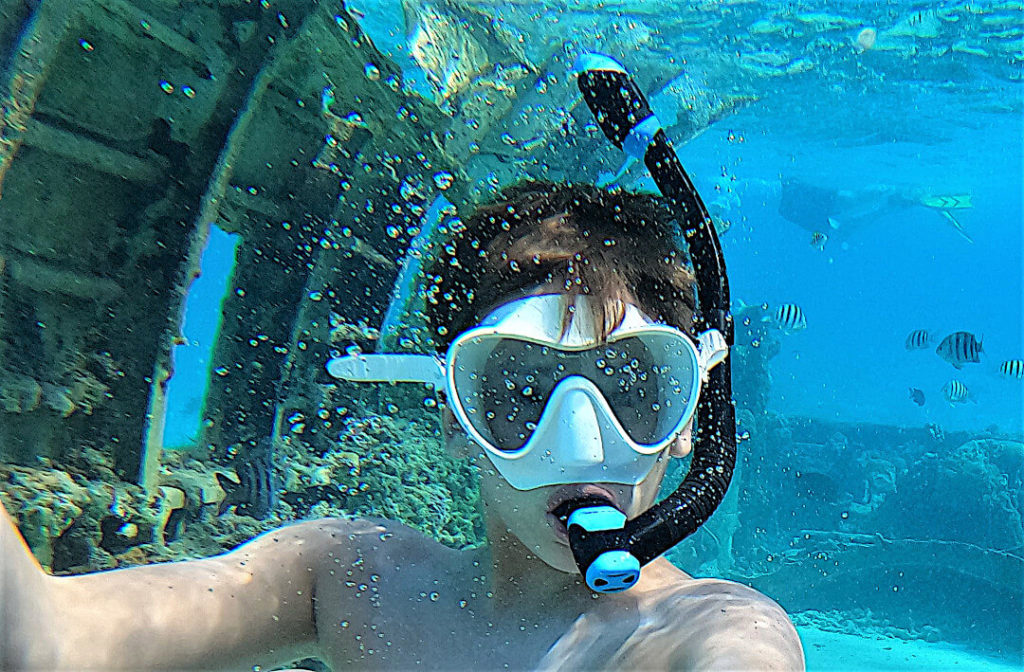
Most charter companies have some snorkel gear available for free at the charter base. However, it may not be high quality or in good condition, and, since the COVID-19 pandemic, some have stopped offering masks and snorkels. We like to borrow fins at the dock to keep weight and bulk out of the luggage, but bring our own masks and snorkels.
Best Snorkel
We prefer a valved snorkel that keeps the water out when you go under or get hit by a wave. We’ve had great luck with the Cressie Supernova Snorkel. It has a lot of flex above the mouthpiece for comfort, and an easy adjustable mask attachment. The ball valve in the top keeps water out when you get hit with a wave or go below the surface. It’s available in lots of colors so you can get one to match your mask, get a few colors to tell which one had who’s dirty mouth on it, or take advantage of clearance pricing on an odd color.
Best Snorkel Mask
The best mask is the one that fits well; consider going to a dive shop and getting fitted to something that is comfortable and well-sealed. We found some good masks this year: the frameless folds and packs easily. We thought the white looked nice, but the black is better for under water visibility…doubling down on the panoramic lens. All Cressi masks come with a plastic case, which is nice to protect them when packed and stored. They cases are large though: we were able to pack two masks in each case
The Cressi F1 Frameless snorkel mask looks sexy, especially in white. Aside from good looks, the only advantage we found in the frameless design was that it packs smaller. Unfortunately, we also found that the lighter color is less ideal for underwater visibility, and would order black next time. Note the F1 is a pretty small mask. George first tried the F1 Kids for his small 12-year old head, but it was too small. The standard F1 was just right for him, but too narrow for the adults.
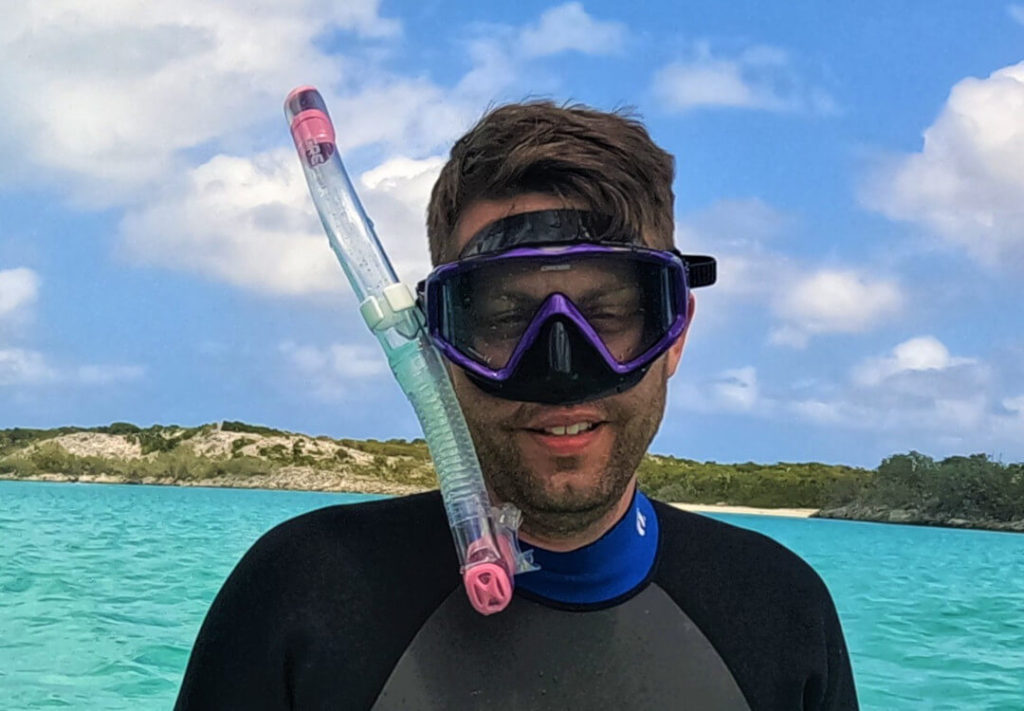
My personal pick for a mask is the Cressi Panoramic, which fit my fat head very comfortably. The side lenses seemed kinda gimmicky, but they really do increase your peripheral vision under water. That’s great if you are claustrophobic, but just generally makes it easier see when snorkeling.
Dive Weights
Dive Weights are a bitch to carry in your luggage, and will get you stopped at security 100% of the time. Divers often rent weights from local dive shops at their destination; in the Bahamas we couldn’t find anyone renting weights so we brought our own and my shoulders are still sore. That said, dive weights are awesome to help get you below the surface when snorkeling to get a closer look at a reef, and almost entirely necessary if you are going to net a spiny lobster. Rubber weight belts are a bit more expensive, but more comfortable at carrying that heavy load than nylon belts. Whatever you get, be sure it has a quick release in case you get into trouble and need to float back to the surface.
Best Binoculars for Boating
Most charter boats come with binoculars, but as we’ve learned, they aren’t always sufficient. We have two sets of binoculars that we’ll choose between based on the packing situation. Whatever binoculars you choose, make sure they float!
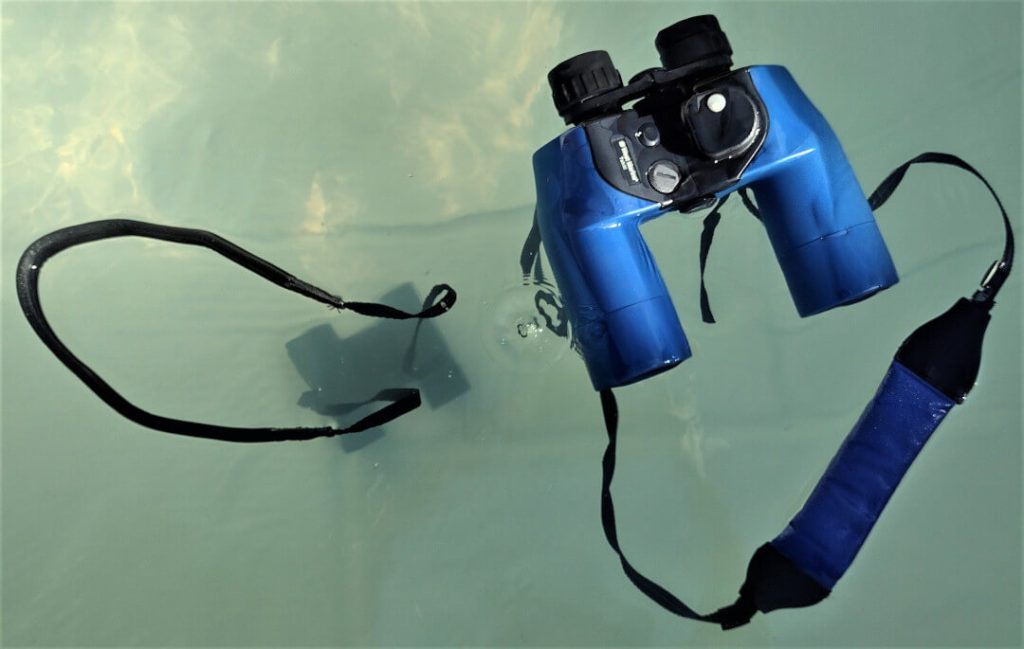
Best Binoculars for Navigation
West Marine Tahiti 7 x 50 binoculars with compass. These are my favorite binoculars. They are easy to lokoout with and without glasses. Made for boating, in addition to floating, they have a built in compass to aid with navigation. However, they are not very portable. The lens caps are flimsy and cumbersome. I threw out the lens caps and rely on the soft case to protect them. The dimensions 7 x 50 (7x magnification, 50mm lenses) are common marine binoculars.
Best Binoculars for Chartering
Our preference for travel is mini-binoculars. We’ve been using the Bushnell H20 8×25. They are waterproof, fog free, and very portable. However, beware that they do not float, so the carry strap is pretty important on these. They come with a well-fitting soft case but no lens caps. The 8 in “8×25” means they have 8x magnification. This means you can see a bit further out than with the Tahitis in exchange for a narrower field of view. I can really tell the difference with these when trying to read a name on another boat’s stern; the extra zoom is helpful. The 25 in “8×25” means the lenses have a 25mm diameter, half as much as the Tahitis. This means you get a smaller unit in exchange for less ability to gather light…both of these models seem equally bright to me.
Bushnell recently updated these to a new model with an aluminum housing that’s lighter and more durable than whatever lies below the rubber molding on my pair. More importantly, they are less expensive.
Best Waterproof Camera Equipment
A waterproof camera is a great for capturing pictures while snorkeling and taking on the dinghy. I tried a few different options this year:
Cheapest waterproof camera option: Ziploc bag or cell phone case
Whether or not you make this your primary camera option, a cheap waterproof case for your phone can save you lots of coin. Just ask the guy who’s lost two phones to Davy Jones locker this year.
The dry bag we recommended above includes a waterproof cell phone case as free gift with purchase.
Low cost, high quality waterproof camera optIon: Polariod underwater camera case
Polaroid used to make a universal plastic case for digital cameras. There is still some new old stock available for a great price. I had an old Panasonic digital camera with nice lens and monster zoom, so we converted that into our underwater camera. It worked pretty good, but some controls were hard to work through the plastic and the zoom could only go so far before hitting the front of the case. Pulling this old camera out of storage worked better than our cell phones for some low light and telephoto shots as well; but new phones are starting to catch up in those areas.
Best Underwater Camera Option: GoPro
After finagling with all the cheap options, and trying a few knock off action cameras in Hawaii in January, I was so impressed with the performance our friend’s GoPro in The Bahamas that I picked one up for our Summer trips. It’s simple, easy to take anywhere, and takes fantastic outdoor photos. It has a very wide angle lens, which, coupled with the front facing screen makes for great selfies. It also makes it easy to capture big landscapes and landmarks. The time lapse mode, mounted to a tri-pod can help capture memories from a full day of sailing.
There are currently three models available: GoPro Hero9, Hero10, and the recently released Hero 11. I ponied up for the Hero10 because I noticed that my Buddy’s Hero9 had a lot of latency in starting up and in the menus. The Hero 10 has a faster processor that fixes this and allows for higher resolution video. All three cameras look identical on the exterior. They use the same battery size and contain lot of the same hardware, but each generation has a better processor that allows for faster, higher resolution recording. However, pushing the envelope on frame rate and resolution eats up memory on your camera (and later on your hard drive) very quickly; it’s also harder for your (my) computer to edit those large video files. So, the Hero9 is sufficient for most purposes. You can often find a better deal buying direct from GoPro with a subscription to their cloud services or a bundle at Costco.com.
Best GoPro Accessories for Boaters
GoPros do not float. So you really need a floating accessory to take them boating. A brrght orange foam case is the safest option since it is easy to see and stays with the camera no matter what. However, the case makes it a pain to swap mountings, change batteries, and it insulates the camera (which has cooling issues already). A floating handle is a versatile option. If you get one with threads at the bottom, like this, you can attach other accessories below it, like a tri-pod or selfie-stick. The cheapest option that we tried was to wrap a short section of foam pool noodle around a selfie-stick. The last option is the least secure: our selfie stick broke when it got knocked over as we drove our narrowboat through a tree. Had the camera went into the drink instead of onto the deck, we would not have ever seen it again.
Best GoPro Batteries and Charging Options
GoPros can eat batteries quickly, so its handy to have extra batteries and a battery charging station so you can swap batteries quickly and make sure you’ve always got one topped off at the ready. I bought the Telesin Battery Storage Charging Box that charges three batteries at once and comes with two Telesin brand batteries that fit the GoPro Hero9/10/11. Having the charging station makes it much easier to charge and carry multiple batteries, as opposed to using the camera to charge them one at a time. I like the Telesin charging station because, it charges three batteries at once (vs 2 for the GoPro version), it closes around the batteries for storage, and its cheap: you can get the Telesin charger with two batteries for less than the empty GoPro charger.
All GoPro batteries, OEM and knockoff, that I’ve seen are rated at 1,720 mAh capacity. However, GoPro introduced the white topped enduro battery last year that has an improved battery chemistry that, despite the same capacity, lasts (up to 40%) longer than the older blue GoPro battery, especially in very cold environments. This new battery ships with the Hero11, but also works in the Hero9 and Hero10. This chemistry phenomenon leaves open the possibility that a similarly rated knock off battery may also perform better or worse than the original blue OEM battery. So, I ran my own tests at home to find out. I set the cameras on a tri-pod in front of a fan (GoPros have powerful processors that can overheat and shut down when not moving). The Telesin batteries ran dead about 10%-12% faster than the standard blue GoPro battery: 71 minutes in highest quality video and 103 minutes on battery saver. Keep in mind these were easy on the camera with ideal temperatures and little movement. In both cases, expect to get less recording time in the real world.
So, if you don’t have a battery charger, I recommend the Telesin two battery charging kit or the a la carte Telesin Charging Station. If you have a charger and just need more batteries, spring for the GoPro Enduro Batteries; with the way GoPro eats batteries, its worth spending a bit extra to squeeze a bit more our of each charge. I always go for my Enduro first because the battery life on these things can be a real nail biter.

very interesting, but nothing sensible